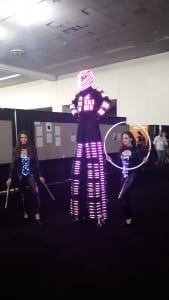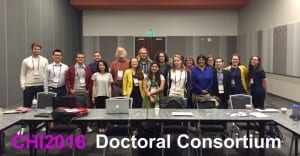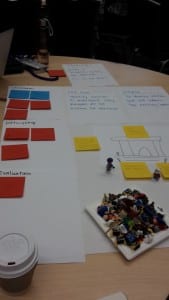Human-computer interaction
By Nathan Davies, on 12 July 2016
In this post, Nikki Newhouse from the eHealth Unit and UCLIC talks about her visit to the CHI’2016 conference in San Jose, California.
In early May, I visited San Jose in California for CHI’16, the biggest annual conference in the HCI (human-computer interaction) calendar. Held over the course of a week, the conference’s scope is enormous, attracting around 3,000 international delegates who come to learn about and discuss how people interact with technology. Delegates are drawn from a wide range of disciplines and it’s an active, exciting event, where academics and students mix and engage directly with entrepreneurs, designers, industry experts and commercial leaders.
I attended as a participant in the CHI’16 Doctoral Consortium (DC). The DC brings together a small, international group of postgraduate students to explore and develop their research under the guidance of an expert panel. Competition to take part is high: 15 places were allocated from 67 applications and I was honoured to be the only student selected from the UK. The panel consisted of Hilary Hutchinson (Google), Alan Borning (University of Washington) and Yvonne Rogers (UCL). Participation in the DC involves attending a 2-day pre-conference workshop during which all attendees present key aspects of their research and receive constructive feedback from the group and panel on how to take their work forward. There was also the opportunity to develop networking skills and chat informally with invited guests from industry and academia.
Consortium attendees’ presentations represented the huge range of interests, questions and approaches that come under the exciting HCI research umbrella. I presented my multidisciplinary research on the use of technology in the transition to first time parenthood; other students’ work included projects on collaborative writing, working with service dogs, how people interact with digital books, rethinking the role of smart cities from a perspective of supporting wellbeing, and designing digital tools for dispersed populations with rare diseases. As well as gaining valuable presentation practice and personalised feedback, we presented a poster within the main conference and our extended abstracts were published in the highly-regarded CHI Extended Abstracts, available in the ACM Digital Library.
The conference benefits from standout keynote speakers from academia and industry and a multi-track programme that includes talks, workshops, courses, lunches, a job fair, interactive demonstrations, special interest groups and even ‘alt.chi’, a forum for ‘controversial presentations’. I attended an exceptional course on positive computing and designing for wellbeing, facilitated by Prof. Rafael Calvo and Dorian Peters (both University of Sydney) in which we explored approaches to evaluating and designing for wellbeing determinants like autonomy, competence, connectedness, meaning, and compassion. I also attended a hands-on course in participatory design methods, hosted by Aarhus University’s Susanne Bödker, Christian Dindler , Ole Sejer Iversen and Kim Halskov. The course gave an overview of participatory design history, practices and methods. Basically, we had a great time solving design challenges with Lego!
Attending CHI’16 has been one of the standout experiences of my PhD and I feel extremely privileged to be one of the ‘Class of 2016’. HCI is an exciting field to work in: it combines academic rigour and methodological pluralism with fun, curiosity and an inherently pragmatic approach to problem solving. CHI’17 will be held in Denver and I’m already excited about attending!
 Close
Close




